
The goatfishes are fish of the family Mullidae, the only family in the order Mulliformes. The family is also sometimes referred to as the red mullets, which also refers more narrowly to the genus Mullus.
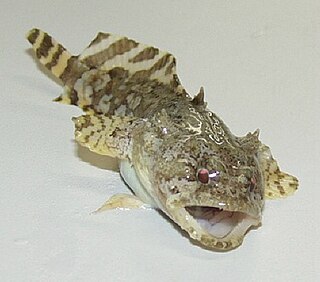
Batrachoididae is the only family in the ray-finned fish order Batrachoidiformes. Members of this family are usually called toadfish or frogfish: both the English common name and scientific name refer to their toad-like appearance.
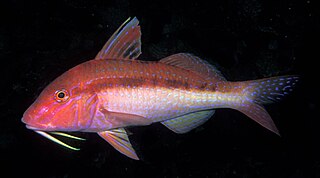
Upeneichthys lineatus, also known as the blue-striped mullet, blue-lined goatfish. blue-striped goatfish, blue-spotted goatfish and blue striped red mullet, is a species of marine ray-finned fish, a goatfish from the family Mullidae. It is native to the Pacific coast of Australia. It occurs in sheltered areas over rocky and sandy substrates and can be found 5 to 100 metres, though rarer below 40 metres (130 ft). This species can reach a length of 40 centimetres (16 in) FL. This species is commercially important.

The dash-and-dot goatfish is a species of goatfish native to the Indian and Pacific oceans.
The long-nose sooty grunter is a species of fish in the family Terapontidae. It is endemic to Australia.
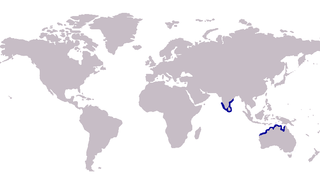
The mud whiting, or mud sillago, is a species of coastal marine fish in the smelt-whiting family Sillaginidae. The mud whiting was first described in 1985 and is currently known from the north west coast of Australia and the Indian coast.

The common bluestripe snapper, bluestripe snapper, bluebanded snapper, bluestripe sea perch, fourline snapper, blue-line snapper or moonlighter, is a species of snapper belonging to the family Lutjanidae. It is native to the Indian Ocean from the coast of Africa and the Red Sea to the central Pacific Ocean. It is commercially important and sought as a game fish. It can also be found in the aquarium trade.

Centroberyx, often referred to as nannygais, is a genus of ray-finned fishes found in the Indian Ocean and western Pacific Ocean, with its greatest species richness off southern Australia. They are reddish in colour and somewhat resemble the related soldierfish. Depending on species, they may have a maximum length of 20 to 66 centimetres. They are found at depths of 10 to 500 metres. Members of this genus are also known from fossils from the Cretaceous.
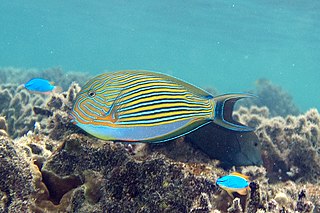
Acanthurus lineatus, the lined surgeonfish, blue banded surgeonfish, blue-lined surgeonfish, clown surgeonfish, pyjama tang, striped surgeonfish, and zebra surgeonfish, is a species of marine ray-finned fish belonging to the family Acanthuridae, the surgeonfishes, unicornfishes and tangs. This species is found in the Indo-Pacific region.

Upeneichthys vlamingii, the blue-spotted goatfish, southern goatfish, black-striped goatfish, blue-striped red mullet, southern red mullet or western red mullet, is a species of marine ray-finned fish, a goatfish from the family Mullidae native to the coast of southern Australia.

Upeneichthys is a genus of goatfishes native to the Indian and Pacific coasts of Australia.
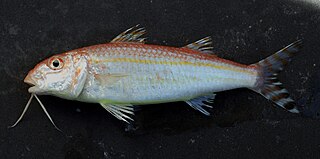
Upeneus is a genus of goatfishes native to the Atlantic, Indian and Pacific oceans.

Cochleoceps orientalis, common name eastern cleaner-clingfish, is a species of clingfish that is endemic to the marine waters around southeastern Australia.

The golden-lined spinefoot, also known as the goldlined rabbitfish or lined rabbitfish, is a species of marine ray-finned fish, a rabbitfish belonging to the family Siganidae. It is found in the tropical Western Pacific and along the coasts of northern Australia.
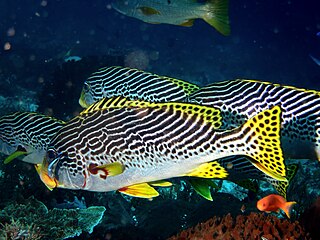
Plectorhinchus lineatus, also known as the yellowbanded sweetlips, oblique-banded sweetlips, diagonal-banded sweetlips, Goldman's sweetlips, lined blubber-lips, lined sweetlips, many-lined sweetlips, striped sweetlips and yellowband sweetlips, is a species of marine ray-finned fish, a sweetlips belonging to the subfamily Plectorhinchinae, one of two subfamilies in the family Haemulidae, the grunts. It inhabits coral reefs of the western Pacific Ocean, where it occurs at depths from 1 to 35 m.
Dactylostomum is a genus of trematodes in the family Opecoelidae. It is synonymised with Opedunculata Dwivedi, 1975.

Cochleoceps bicolor, the western cleaner clingfish, is a species of clingfish from the family Gobiesocidae which is endemic to southern Australia. This species has a ground colouration which varies from yellowish to reddish marked with regular transverse blue bands along its back and a bluish-grey caudal fin. This species occurs on rocky reefs and jetty or pier piles, where they establish cleaning stations, often over sponges and ascidians, but are known to use a wide variety of reef related sites as stations, perhaps the most important criterion being the prominent visibility of a site to passing parasite laden clients .A station may have from one to multiple Western Cleaner Clingfish, depending on the demand for services and other factors. Some divers have observed shared stations, where several other known temperate marine cleaner host species-notably juvenile moonlighter fish and rockpool shrimp - behave in cooperative fashion, possibly when client demand peaks, tide and season depending. They are thought to feed on parasites which they clean off larger fish. The distribution of this species extends from Lancelin, Western Australia to Port Phillip in Victoria. C. bicolor was described in 1991 by Barry Hutchins from a type locality of Flinders Island.

Upeneus pori is a species of marine ray-finned fish, a goatfish from the family Mullidae which is found in western Indian Ocean and the eastern Mediterranean Sea.

Hephaestus is a genus of freshwater ray-finned fish, grunters from the family Terapontidae.

Lophiocharon hutchinsi, known as Hutchins' anglerfish, is a species of fish in the family Antennariidae. It is native to the Western Pacific, where it has been reported from Australia and the Aru Islands. It occurs at a depth range of 2 to 9 m and reaches 4.9 cm SL. The species is benthopelagic and has been collected from areas with sandy mud, seagrass, and sponges, and it was first described in 2004 and named after Barry Hutchins of the Western Australian Museum. It differs from other members of the genus Lophiocharon in fin morphology, with the illicium of this species being smaller and bearing a less distinct esca.

















